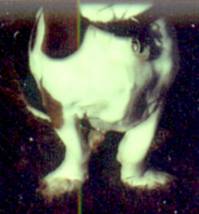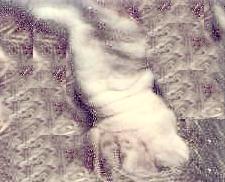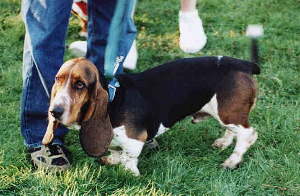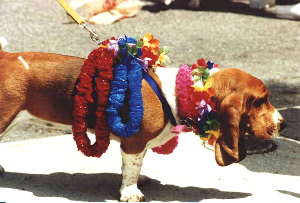
The Chest is deep and full with prominent sternum showing clearly in front of the legs. The Shoulders and Elbows are set close against the sides of the chest. The distance from the deepest point of the chest to the ground, while it must be adequate to allow for free movement when working in the field, is not to be more than one-third the total height at the withers of an adult Basset. The shoulders are well laid back and powerful. Steepness in shoulder, fiddle fronts, and elbows that are out, are serious faults.
The Forelegs are short, powerful, heavy in bone, with wrinkled skin. Knuckling Over of the Front Legs Is a Disqualification. The Paw is massive, very heavy with tough heavy pads, well rounded and with both feet inclined equally a trifle outward, balancing the width of the shoulders. Feet down at the pastern are a serious fault. The Toes are neither pinched together nor splayed, with the weight of the forepart of the body borne evenly on each. The Dewclaws may be removed.
WHAT TO LOOK FOR:
A full, deep chest with prominent sternum, showing clearly in front of the legs when viewed in profile. The sternum bone should be felt. The shoulder assembly should be far enough back on the body. The perpendicular front leg should, in profile, cover the deepest point of the chest, thereby putting the support of the leg under the deepest part. The shoulder blade and the upper arm should be of approximately equal length and should meet to form a right angle (90 degree). The elbow should be set in a vertical line directly below the withers, closely hugging the body. If the shoulder is placed back far enough, and the chest is broad enough, the upper arm, of necessity, is slightly curved when viewed from the front.
The Forelegs are strong and heavy-boned. The Basset is a heavy-boned hound, whose weight must be supported on sound, substantially boned front legs.
The paw is massive, tough, strong, and the feet are inclined equally a bit outward so that when viewed from the front, the outermost point of the paw and the outermost point of the shoulder meet in a vertical line. The toes to be strong and well knuckled-up, each bearing equal weight.
WHAT TO AVOID:
Avoid flat-chested dogs or those with narrow, v-shaped chests, as well as overly broad-chested dogs. Make sure you feel for the sternum bone.It is easy to be deceived by fat or loose hanging skin that only appears to be a prominent sternum.
Avoid shoulder assemblies too far forward. Shoulders that are straighter than approximately 45 degrees. Blade bones and upper arms that are not of nearly equal length. Upper arms that don't meet blade bones at 90 degree angle. Elbows that are out. Elbows that are not in vertical line with the withers. When the humerus is shorter than the radius and the shoulder, the legs are automatically brought forward, causing the bulk of the body weight to be behind, not between, the legs. This then causes the knees to knuckle forward, the elbows to come out and the pasterns to bend, making a very deformed and incorrect front assembly.
Avoid any weakness in leg or light bone.
Knuckling Over MUST be Disqualified. You will not see this particular fault too often in the show ring, and it is a hard one to detect at times. I have only disqualified one Basset for knuckling since I have been judging and that was at a specialty show just a few years ago.
This particular dog was rather nice and would have been in the ribbons, had it not had this disqualifying fault, unlike two other dogs that were shown to me that day on which I withheld ribbons. (I had a really good day). Pay attention if you see the dog's wrist joint start to quiver and if in doubt, you might tap the dog on the back of the foreleg to see if it will "break". Also, make the dog walk slowly. Make sure you feel the joint, because oftentimes loose hanging skin can make a dog look like it is knuckling when it is not.
Avoid feet turned too far out, or pointing straight ahead, or inward. Splayed feet, flat feet or any deficiency in feet. Thin pads. Down in pasterns.
I was shocked at our last Nationals to see so many bad feet. Splayed, paper thin, flat footed - it seemed every possible foot fault was there for viewing. This had not formerly been one of our major concerns, but it now appears that our breeders must be very vigilant to correct this, and the judges must be aware of it and not reward it. A Basset Hound in the field must travel through rough terrain and they could not possibly do it without proper feet and legs.
Go to the Forequarters section of the Illustrated Standard

This bitch has good layback
with prominent sternum and elbows tight against the body. She also has
a pleasing feminine head, and although a lemon & white, has lovely
dark pigmentation

This is a good picture of
a Basset with a Fiddle Front
This is a picture of knuckling
over, and I apologize that it is so faded, but I think you can get the
idea
The following photos were taken off the rescue parade web page:


This dog has a roach back and appears to be knuckled over
This dog has very shallow
chest, bulldog front, short ears and neck, roached topline, low tail set,
and appears to be knuckled over.

Absolutely straight front with no prosternum. High ear set, short ears, muzzle too short, etc